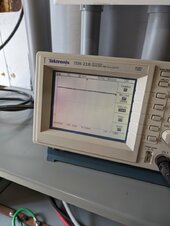hpeyerl
New Member
- Joined
- Mar 22, 2022
- Messages
- 93
Discovered this the unpleasant way, while up on my roof.
In short (pun not intended) I discovered 240vdc present between the ground bar in my Sol-Ark 15k, and the MPPT + terminals, if the 'DC' switch is turned 'ON'.
This has the unfortunate "side effect" of making my entire roof be 240vdc positive if someone touches any of the PV positive lines even if my RSD is active (ie: 0v PV).
In the photo, my meter positive is resting on one of the bolts on my GND bus bar, and the meter negative is resting on the MPPT3+ screw. The panels are disconnected but the ground that comes from the roof is still connected (far left bolt on the ground bus bar). If I turn off the 'DC' switch on the side of the inverter, it all goes to 0vdc.
So I'm asking myself whether it is expected that the inverter is putting 240vdc on the ground (and since the ground is bonded to neutral, there's also 240vdc on the neutral).

In short (pun not intended) I discovered 240vdc present between the ground bar in my Sol-Ark 15k, and the MPPT + terminals, if the 'DC' switch is turned 'ON'.
This has the unfortunate "side effect" of making my entire roof be 240vdc positive if someone touches any of the PV positive lines even if my RSD is active (ie: 0v PV).
In the photo, my meter positive is resting on one of the bolts on my GND bus bar, and the meter negative is resting on the MPPT3+ screw. The panels are disconnected but the ground that comes from the roof is still connected (far left bolt on the ground bus bar). If I turn off the 'DC' switch on the side of the inverter, it all goes to 0vdc.
So I'm asking myself whether it is expected that the inverter is putting 240vdc on the ground (and since the ground is bonded to neutral, there's also 240vdc on the neutral).




